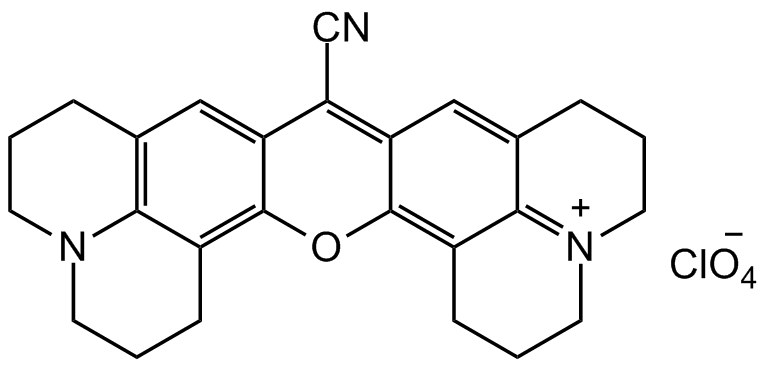Rhodamine 800
Product Code:
CDX-R0137
CDX-R0137
Regulatory Status:
RUO
RUO
Shipping:
AMBIENT
AMBIENT
Storage:
Short term storage:-20°C. Long term storage:-20°C.
Short term storage:-20°C. Long term storage:-20°C.
No additional charges, what you see is what you pay! *
| Code | Size | Price |
|---|
| CDX-R0137-M250 | 250 mg | £103.00 |
Quantity:
Prices exclude any Taxes / VAT
Stay in control of your spending. These prices have no additional charges, not even shipping!
* Rare exceptions are clearly labelled (only 0.14% of items!).
* Rare exceptions are clearly labelled (only 0.14% of items!).
Multibuy discounts available! Contact us to find what you can save.
This product comes from: Switzerland.
Typical lead time: 7-10 working days.
Contact us for more accurate information.
Typical lead time: 7-10 working days.
Contact us for more accurate information.
- Further Information
- Documents
- References
- Show All
Further Information
Appearance:
Dark purple to black powder.
CAS:
137993-41-0
EClass:
32160000
Form (Short):
solid
Handling Advice:
Protect from light and moisture.
InChi:
InChI=1S/C26H26N3O.ClHO4/c27-15-22-20-13-16-5-1-9-28-11-3-7-18(23(16)28)25(20)30-26-19-8-4-12-29-10-2-6-17(24(19)29)14-21(22)26;2-1(3,4)5/h13-14H,1-12H2;(H,2,3,4,5)/q+1;/p-1
InChiKey:
HACOCUMLBPNDIN-UHFFFAOYSA-M
Long Description:
Chemical. CAS: 137993-41-0. Formula: C26H26ClN3O5. MW: 495.95. Rhodamine 800 is a near-infrared fluorescent dye, which was originally developed as a laser dye. Rhodamine 800 belongs to the rhodamine family and is one of the few rhodamines that have near infrared fluorescence. It displays bright red-orange fluorescence, making it an ideal choice for labeling proteins, nucleic acids, and other molecules in biochemical studies. Rhodamine 800 finds widespread use in research and analytical applications. It is used for detecting proteins in cells, tracking molecule movement and studying molecular interactions. In fluorescence microscopy and imaging, Rhodamine 800 enables visualization of organelles and molecules within living cells. It proves valuable in flow cytometry for measuring DNA levels and quantifying proteins and other molecules. It has been studied in biosensing applications, and it has been explored as a probe for detecting hydrogen sulfide, metal ions, reactive oxygen species, intracellular pH, DNA, and lipid rafts. Rhodamine 800 is used for staining mitochondria. Rhodamine dyes are membrane-permeable cationic fluorescent probes that specifically recognize mitochondrial membrane potentials, thereby attaching to mitochondria and producing bright fluorescence, and at certain concentrations, rhodamine dyes have low toxicity to cells, so they are commonly used to detect mitochondria in animal cells, plant cells and microorganisms. Rhodamine 800 is widely used as an optical probe, as well as in lasers and solar cells. It can effectively bind to nanostructures and surface plasmon polariton. Spectral Data: lambdaex 682 nm; lambdaem 712 nm in methanol / lambdaex 676 nm, lambdaem 704 nm in DMSO.
MDL:
MFCD00467020
Molecular Formula:
C26H26ClN3O5
Molecular Weight:
495.95
Package Type:
Vial
Product Description:
Rhodamine 800 is a near-infrared fluorescent dye, which was originally developed as a laser dye. Rhodamine 800 belongs to the rhodamine family and is one of the few rhodamines that have near infrared fluorescence. It displays bright red-orange fluorescence, making it an ideal choice for labeling proteins, nucleic acids, and other molecules in biochemical studies. Rhodamine 800 finds widespread use in research and analytical applications. It is used for detecting proteins in cells, tracking molecule movement and studying molecular interactions. In fluorescence microscopy and imaging, Rhodamine 800 enables visualization of organelles and molecules within living cells. It proves valuable in flow cytometry for measuring DNA levels and quantifying proteins and other molecules. It has been studied in biosensing applications, and it has been explored as a probe for detecting hydrogen sulfide, metal ions, reactive oxygen species, intracellular pH, DNA, and lipid rafts. Rhodamine 800 is used for staining mitochondria. Rhodamine dyes are membrane-permeable cationic fluorescent probes that specifically recognize mitochondrial membrane potentials, thereby attaching to mitochondria and producing bright fluorescence, and at certain concentrations, rhodamine dyes have low toxicity to cells, so they are commonly used to detect mitochondria in animal cells, plant cells and microorganisms. Rhodamine 800 is widely used as an optical probe, as well as in lasers and solar cells. It can effectively bind to nanostructures and surface plasmon polariton. Spectral Data: lambdaex 682 nm; lambdaem 712 nm in methanol / lambdaex 676 nm, lambdaem 704 nm in DMSO.
Purity:
>95% (HPLC)
SMILES:
[O-]Cl(=O)(=O)=O.N#CC1=C2C=C3CCC[N+]4=C3C(CCC4)=C2Oc5c6CCCN7CCCc(cc15)c67
Solubility Chemicals:
Soluble in ethanol, methanol or~DMSO (20mg/ml).
Source / Host:
Synthetic
Transportation:
Non-hazardous
UNSPSC Number:
41105331
Use & Stability:
Stable for at least 2 years after receipt when stored at -20°C.
Documents
References
(1) T. Imasaka, et al.; Anal. Chem. 61, 2285 (1989) | (2) S.V. Rahavendran & H.T. Karnes; Anal. Chem. 68, 3763 (1996) | (3) J. Sakanoue, et al.; J. Biochem. 121, 29 (1997) | (4) O.O. Abugo, et al.; Anal. Biochem. 279, 142 (2000) | (5) K. Sekiguchi, et al.; J. Phys. Chem. A 110, 2601 (2006) | (6) O. Jilkina, et al.; J. Biomed. Opt. 11, 014009 (2006) | (7) T. Jin, et al.; Sensors 10, 2438 (2010) | (8) F. Valmorra, et al.; Appl. Phys. Lett. 99, 51110 (2011) | (9) J.R. Sanchez-Valencia, et al.; Phys. Chem. Chem. Phys. 13, 7071 (2011) | (10) G. Munch, et al.; J. Biomed. Opt. 16, 65001 (2011) | (11) C. Iwuji, et al.; Nanosci. J. 1, 1 (2018) | (12) W. Yang, et al.; Analyst 144, 5617 (2019) | (13) V.V. Kostjukov; J. Mol. Model. 28, 52 (2022)



